6.1 An Introduction to Evolution
The definition
Biological evolution, simply put, is descent with modification. This definition encompasses small-scale evolution (changes in gene — or more precisely and technically, allele — frequency in a population from one generation to the next) and large-scale evolution (the descent of different species from a common ancestor over many generations). Evolution helps us to understand the history of life.
The explanation
Biological evolution is not simply a matter of change over time. Lots of things change over time: trees lose their leaves, mountain ranges rise and erode, but they aren’t examples of biological evolution because they don’t involve descent through genetic inheritance.
The central idea of biological evolution is that all life on Earth shares a common ancestor, just as you and your cousins share a common grandmother. Through the process of descent with modification, the common ancestor of life on Earth gave rise to the fantastic diversity that we see documented in the fossil record and around us today. Evolution means that we’re all distant cousins: humans and oak trees, hummingbirds and whales.
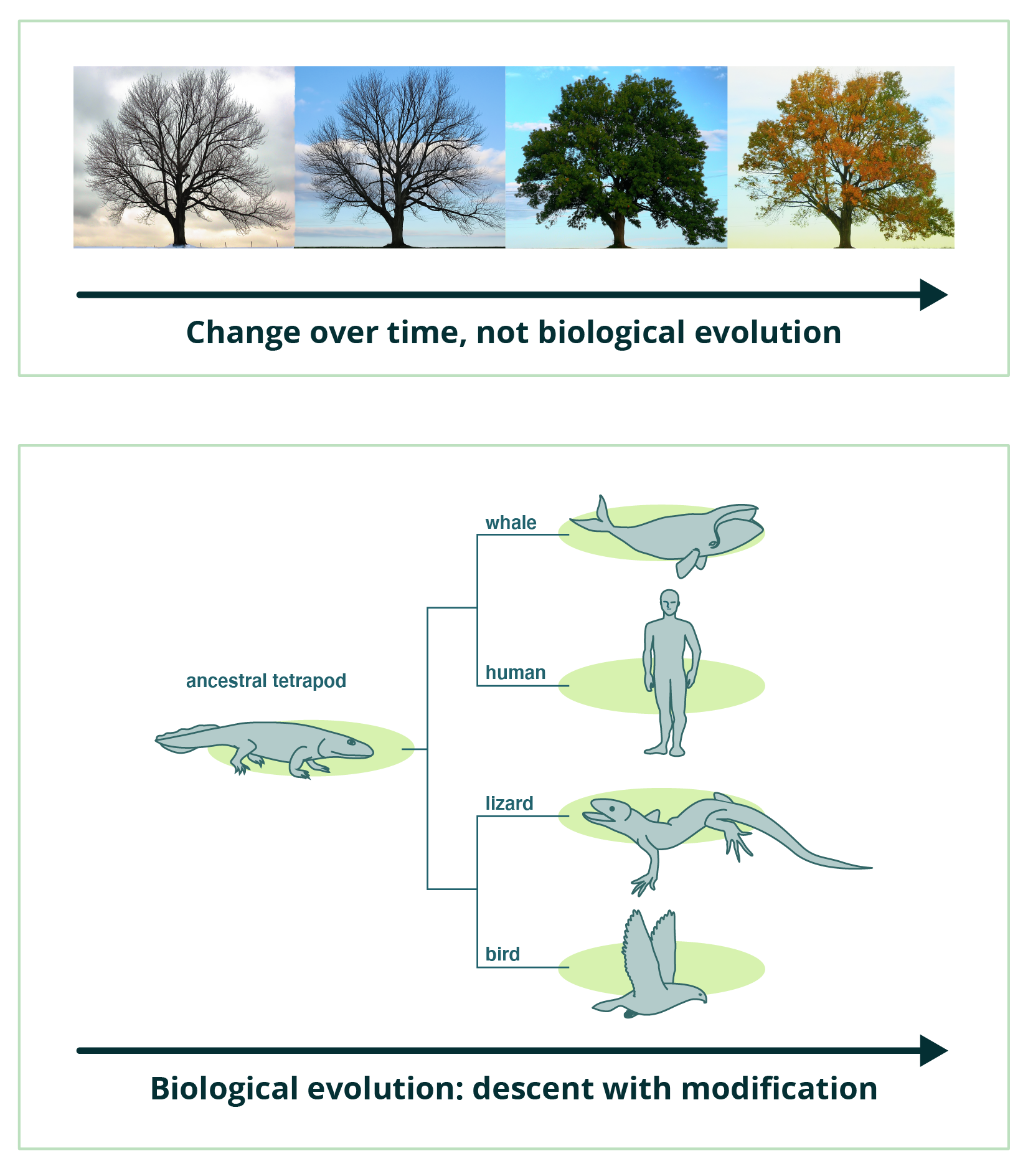
Mechanisms: the processes of evolution
Evolution is the process by which modern organisms have descended from ancient ancestors. Evolution is responsible for both the remarkable similarities we see across all life and the amazing diversity of that life — but exactly how does it work?
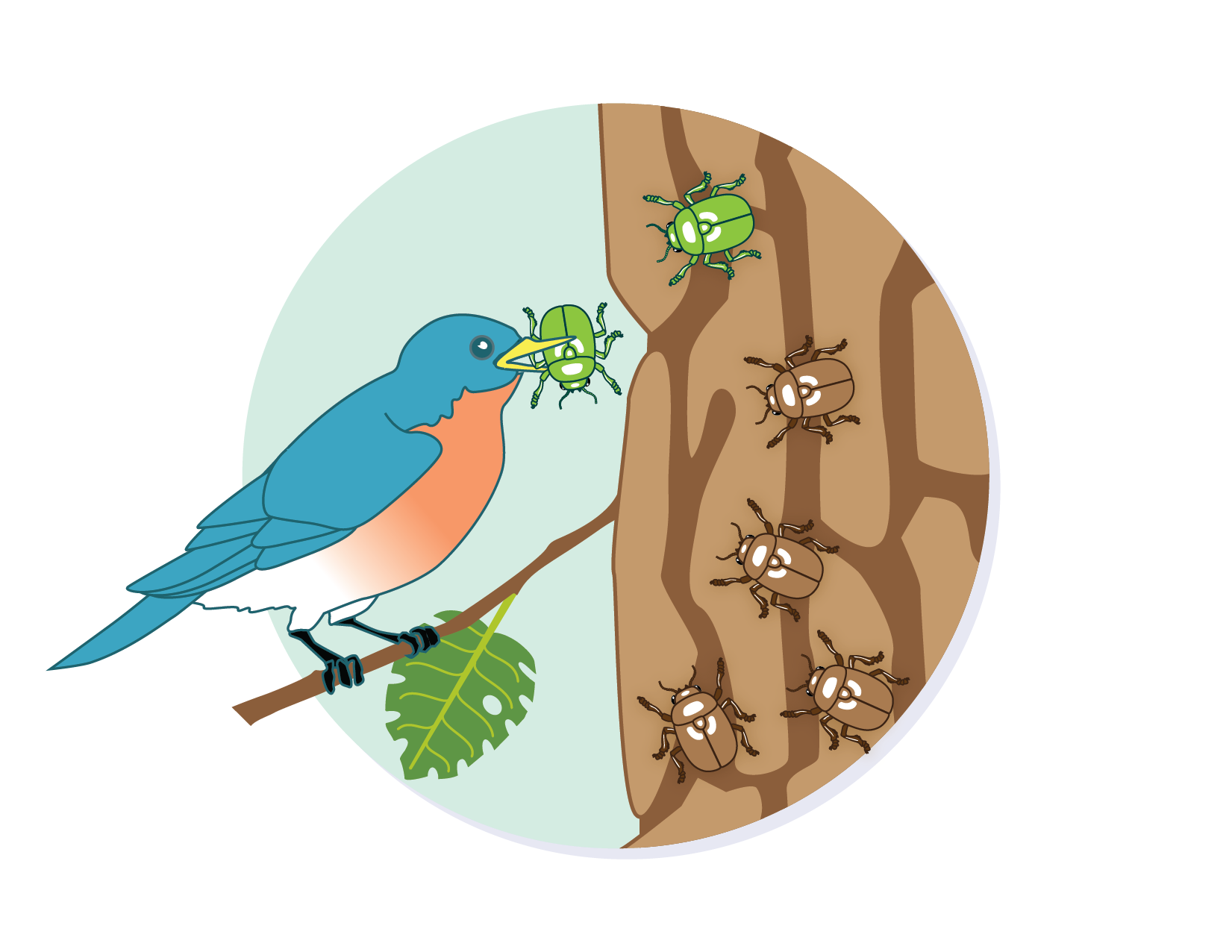
Descent with modification
We’ve defined evolution as descent with modification from a common ancestor, but exactly what has been modified? Evolution only occurs when there is a change in gene frequency within a population over time. These genetic differences are heritable and can be passed on to the next generation — which is what really matters in evolution: long term change.
For evolution to occur, a few conditions must be met:
- Variation within the population: Different individuals within a population have different traits. This is variation. The fundamental sources of variation are mutations. Variation can then move through a population or between populations through reproduction, migration, or genetic drift.
- Natural selection: Some condition places selective pressure on a population. This is a condition, usually imposed by the environment, which will make it more difficult to survive or reproduce.
- Adaptation: The traits of some individuals in the population cause them to be more resistant to the selective pressure. These traits then are called adaptations. The individuals with the trait are said to be more “fit” than those without the trait.
- Evolution: The survival or reproductive rate of individuals with the adaptation is higher. Therefore, the genes responsible for the adaptation become more common in future generations of the population. Evolution has occurred.
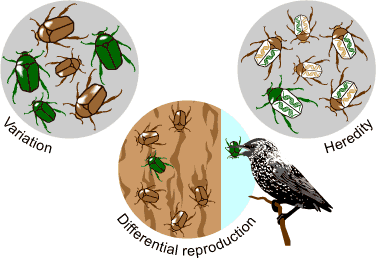
Compare these two examples of change in beetle populations. Which one is an example of evolution?
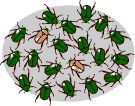 1. Beetles on a diet
1. Beetles on a diet
Imagine a year or two of drought in which there are few plants that these beetles can eat.
 All the beetles have the same chances of survival and reproduction, but because of food restrictions, the beetles in the population are a little smaller than the preceding generation of beetles.
All the beetles have the same chances of survival and reproduction, but because of food restrictions, the beetles in the population are a little smaller than the preceding generation of beetles.
2. Beetles of a different color
 Most of the beetles in the population (say 90%) have the genes for bright green coloration and a few of them (10%) have a gene that makes them more brown.
Most of the beetles in the population (say 90%) have the genes for bright green coloration and a few of them (10%) have a gene that makes them more brown.
 Some number of generations later, things have changed: brown beetles are more common than they used to be and make up 70% of the population.
Some number of generations later, things have changed: brown beetles are more common than they used to be and make up 70% of the population.
Which example illustrates descent with modification — a change in gene frequency over time?
The difference in weight in example 1 came about because of environmental influences — the low food supply — not because of a change in the frequency of genes. Therefore, example 1 is not evolution. Because the small body size in this population was not genetically determined, this generation of small-bodied beetles will produce beetles that will grow to normal size if they have a normal food supply.
The changing color in example 2 is definitely evolution: these two generations of the same population are genetically different. But how did it happen?
As stated earlier, variation (or diversity) within a population is a requirement of evolution. Mutations are the fundamental origin of all variation.
Mutation
 A mutation could cause parents with genes for bright green coloration to have offspring with a gene for brown coloration. That would make genes for brown coloration more frequent in the population than they were before the mutation.
A mutation could cause parents with genes for bright green coloration to have offspring with a gene for brown coloration. That would make genes for brown coloration more frequent in the population than they were before the mutation.
Migration
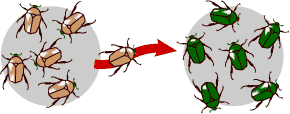 Some individuals from a population of brown beetles might have joined a population of green beetles. That would make genes for brown coloration more frequent in the green beetle population than they were before the brown beetles migrated into it.
Some individuals from a population of brown beetles might have joined a population of green beetles. That would make genes for brown coloration more frequent in the green beetle population than they were before the brown beetles migrated into it.
Genetic drift
 Imagine that in one generation, two brown beetles happened to have four offspring survive to reproduce. Several green beetles were killed when someone stepped on them and had no offspring. The next generation would have a few more brown beetles than the previous generation — but just by chance. These chance changes from generation to generation are known as genetic drift.
Imagine that in one generation, two brown beetles happened to have four offspring survive to reproduce. Several green beetles were killed when someone stepped on them and had no offspring. The next generation would have a few more brown beetles than the previous generation — but just by chance. These chance changes from generation to generation are known as genetic drift.
Natural selection
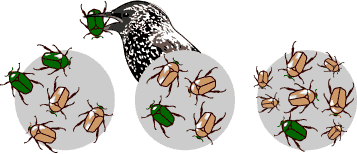 Imagine that green beetles are easier for birds to spot (and hence, eat). Brown beetles are a little more likely to survive to produce offspring. They pass their genes for brown coloration on to their offspring. So in the next generation, brown beetles are more common than in the previous generation.
Imagine that green beetles are easier for birds to spot (and hence, eat). Brown beetles are a little more likely to survive to produce offspring. They pass their genes for brown coloration on to their offspring. So in the next generation, brown beetles are more common than in the previous generation.
All of these mechanisms can cause changes in the frequencies of genes in populations, and so all of them are mechanisms of evolutionary change. However, natural selection and genetic drift cannot operate unless there is genetic variation — that is, unless some individuals are genetically different from others. If the population of beetles were 100% green, selection and drift would not have any effect because their genetic make-up could not change.
Attribution:
This section is cloned from Environmental Biology, by Matthew R. Fisher, Oregon Coast Community College, published using Pressbooks, under a CC BY (Attribution) license. It may differ from the original.
Media Attributions
- natselect02_birdeatingbeetles
- mechan_intro
